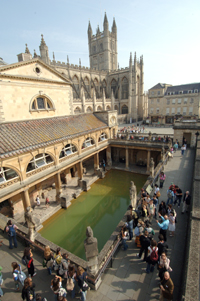Sisters
Coventina's well is not the only goddess-related site I love. Here are a few of my favourites.

Shrine of Sulis Minerva, Bath, England

Sulis is a goddess. This photograph is of the gilded bronze head of the Roman temple's cult statue. Like Coventina, Sulis was worshipped as a local goddess of water. Coventina has an energetic cold water spring. Sulis's rising water is at a temperature of 40 degrees celsius and comes to the surface at the rate of about a million litres a day. The thermal springs are unique in these islands and still feed the spa baths after which the modern day city of Bath is named. I think it's a pity that the city of Bath isn't entirely geothermically powered, but perhaps one day it will be.
Again, like Coventina, the waters of Sulis were considered sacred long before the Romans invaded. The waters contain copper and other minerals, which used to stain the earth around them with red. It must have been an amazing sight in Celtic times, a huge steaming pool of water surrounded by reddish rocks and earth. The local indigenous population built earthworks nearby, projecting into the water, and threw offerings into the depths. Once the Romans arrived, they built a magnificent temple beside the spring, a huge bath complex, and a city. At the height of the empire's power, visitors came from all over the known world to bathe and worship here.
The Romans called their city Aquae Sulis ("the waters of Sulis"), and even renamed the goddess herself as Sulis Minerva, probably because they saw similarities between the Celtic goddess and their own Minerva. Minerva is often thought of today as a war goddess, but originally, when she was known as Menvra by the Etruscans (an early Italian people), she was known for her wisdom and her arts. We know from the many objects found in the spring that Sulis' worshippers appealed to her to heal them and to curse their enemies. The temple prospered for more than four centuries. After the Christian emperor Theodosius closed the pagan temples, and the Romans retreated, Sulis' waters and temple were neglected and eventually forgotten.

But after a long period of obscurity, the site was rediscovered. Today the remains of her temple can be visited in the dark and steamy depths of the site's archaeological museum.
The whole beautiful city of Bath now has World Heritage Site status, and the Roman Baths have an excellent website that gives a good idea of the extent and nature of the site. I can strongly recommend a visit to the city and especially the museum, as the entire place is atmospheric and fascinating.
Wikipedia has a good article about the goddess Sulis.
Statue of Minerva, Chester, England
Minerva was widely worshipped all over the Roman Empire. Another shrine of hers survives in England, near the city of Chester on the Welsh border.
Chester is a pretty place with the most complete surviving set of city walls in these islands surrounding busy lanes, but you can leave the bustling streets behind and cross the river to a quiet park, where, hundreds of years ago, the Romans quarried sandstone. The workers carved a statue into an outcrop of the rock, and it's still there today.

To the left is a photograph of the statue as it appears today.
It is now the only carving of its kind in Western Europe that is still in its original location. As you can see from the photograph on the left, it has suffered terribly over the years, from a combination of weathering, vandalism, and accidental damage. Sadly it is now only faintly discernable.
However, because the image is so hard to make out, it was saved from destruction during Medieval times, as it was mistaken then for a statue of the Virgin Mary!
However damaged it is, it's pretty amazing to find such an ancient statue in a park!

On the right is an artist's impression of how the statue may have appeared when it was first carved.
We know from remaining traces of pigment on other statues that most ancient statuary was brightly painted.
The statue shows Minerva wearing a helmet, carrying a shield, and armed with a spear, all symbols of strength and protection. She is accompanied by her familiar, an owl, symbol of wisdom. So for the Roman soldiers who carved this image, who were both craftsmen and warriors, they must have seen her as having much in common with their experience.
When the statue was in regular use, the altar in the bottom left of the carving was probably used for offerings. The temple at Bath was large, elaborate and luxurious; this shrine was small, simple and functional.
Local conservationists have built a shelter around the carving to save it from further weathering. They couldn't take it down and transfer it wholesale into a museum, as because it is carved into the rock, any attempt to move it would destroy it completely. The local museum has a whole section devoted to Roman carvings found in the area, including a cast of the Minerva shrine.


The Story of Coventina · The Seventh City upon the Wall · Coventina in Context · Fact & Folklore
Images · Archaeological Site · Spirituality
Other Goddess Sites · Fanlisting · Contact · Home

Graphics © FMG · Valid XHTML & CSS · Pro standards & access
All original content © Tehomet 2005



